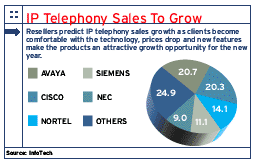IP Telephony To Take Off
"Voice-over-IP has become more of a mainstream product," said Dennis Gorecki, marketing manager at Data Comm Networking, a solution provider in Burr Ridge, Ill., that is expecting to grow its IP telephony business by 50 percent in the new year.
"It's more accepted by the community in general," he added.

Market acceptance for VoIP among customers will continue to grow through 2004 in part because prominent service providers, such as AT&T and SBC Communications, are adding VoIP services to their portfolios, said Jim Puchbauer, director of marketing at AltiGen Communications, an IP communications vendor in Fremont, Calif.
"It's going to continue to drill in the message that the way of the future is VoIP," he said.
Early estimates for U.S. IP-PBX line shipments call for growth of 35 percent or more in 2004, said Frank Stinson, program director at research firm InfoTech. The projected growth will be spurred in part by improvements in the economy that free up spending and customers' increased comfort level with the technology, Stinson said.
Another driver will be the continued decline of VoIP product pricing.
With new vendors such as Zultys Technologies introducing lower-cost options into the market, bigger players will be forced to drop prices, especially on IP handsets, said Don Gulling, president of Verteks Consulting, a solution provider in Ocala, Fla., that expects its IP-PBX sales to double in 2004.
Research firm Dell'Oro Group expects the average selling price of IP telephones to drop to $185 by the second quarter of 2004, down from $193 in the second quarter of 2003.
At the same time, vendors such as 3Com, Avaya and Cisco Systems have plans to bolster their product lines by adding videoconferencing to IP phone calls and increasing the use of presence-based technologies that show when users are logged in and available.
The technology behind these feature advances will be based on Session Initiation Protocol (SIP), an emerging call control standard that opens the door for multimedia communications and facilitates interoperability between equipment from different vendors.
"SIP is going to mean less in the way of proprietary [technology] and more in the way of pervasive remote distribution of phones," said Mike LeBlanc, president of LeBlanc Communications, a Trumbull, Conn.-based solution provider.
Solution providers also could find revenue opportunities in the new year by developing customized XML applications to run in VoIP environments for both horizontal and vertical market customers, said Steve Raab, senior analyst at Dell'Oro Group.
For example, applications that tie time cards, corporate news distribution, hotel wake-up calls or airline flight information to IP phones could enhance employee productivity and attract new customers to IP telephony, he said.
"There's no one primary driver [for IP telephony sales]," Raab said. "It's a collection of small things."